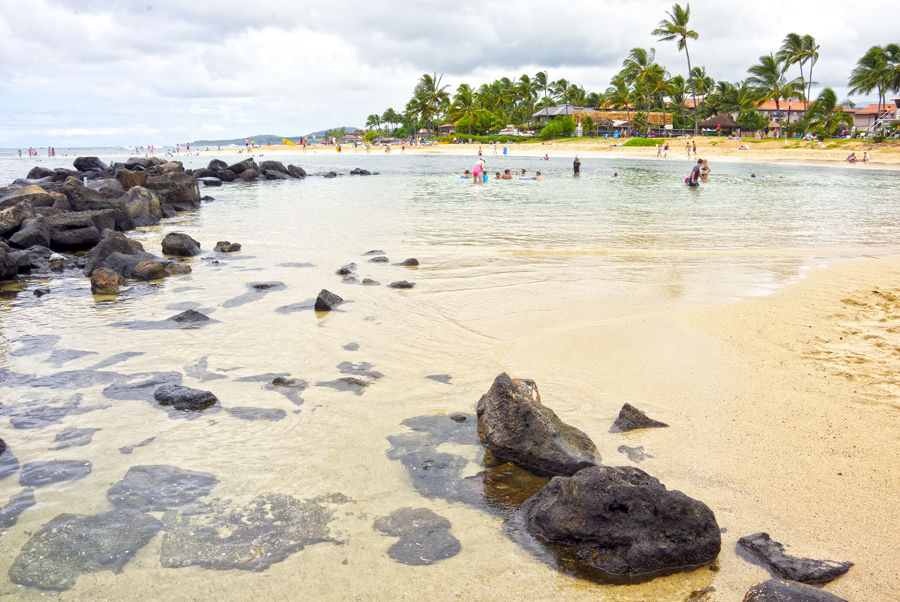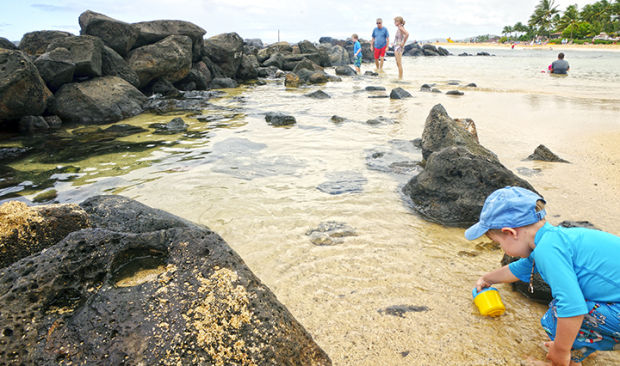LIHUE — Those looking to surf, swim and bask in clean ocean water should look no further than sunny Poipu. The Natural Resource Defense Council has named Poipu Beach Park on Kauai’s South Shore as one of 35 “superstar” beaches
LIHUE — Those looking to surf, swim and bask in clean ocean water should look no further than sunny Poipu.
The Natural Resource Defense Council has named Poipu Beach Park on Kauai’s South Shore as one of 35 “superstar” beaches in the nation for consistently meeting water quality benchmarks.
Noah Garrison, an attorney with NRDC’s Water Program, called the designation “significant.”
“It shows that (Poipu), not just for this year, but for a long-term trend, (has) very little pollution,” he said. “That means people can feel pretty good that they’re not going to come down with a waterborne illness.”
NRDC named 35 beaches from 14 different states to the “superstar” list, including three in Hawaii — Poipu Beach, Hapuna Beach Recreation Area on Big Island and Wailea Beach Park on Maui.
Superstars, as identified in the report, are those that did not exceed the national standard between 2009 and 2012 by more than 2 percent, as well as the Environmental Protection Agency’s new, more protective water quality threshold, the Beach Action Value, by more than 2 percent in 2013, according to the report. Although not federally mandated, EPA suggests states use BAV as a “conservative, precautionary tool for making beach notification decisions.”
Of 63 water samples collected at Poipu Beach Park during 2013, zero exceeded the BAV threshold.
Jody Kjeldsen, executive director of the Poipu Beach Resort Association, said the area has always been touted as having excellent water quality. However, this is the first time it has been recognized as a national superstar — a designation she certainly welcomes.
“I think both from the visitor and residential perspective, everyone recognizes the cleanness and the clarity of the water in Poipu,” she said.
Erin Easterday, of McMinnville, Ore., and her 2-year-old son Ledger spent Wednesday morning at Poipu Beach Park, playing in the sand and splashing in the shallow water of the park’s kiddie pond.
“This is a great beach.” she said. “We have some great beaches, too, but you have the weather we don’t.”
Bob French, owner of Brennecke’s Beach Broiler, described the news as “wonderful” and said he is sure the water is much cleaner today than it was two years ago.
In 2012, French’s business paid a fine of more than $47,000 to the EPA for failing to close two large capacity cesspools. As part of $1.2 million in upgrades, Brennecke’s funded $500,000 in improvements for sewage treatment from Poipu Beach Park’s public restrooms.
In his free time, French enjoys stand-up paddle boarding in the area.
“I love to stand up and look right down at the fish, 25 feet under me,” he said. “When you get out there, you can see the clarity of the water is beautiful.”
Nearby Sheraton and Brennecke beaches also had perfect water quality records during 2013, with zero BAV exceedences, according to the report.
On a sour note, however, Kauai is home to three of Hawaii’s five most polluted beaches — those with the highest BAV exceedance rates in 2013.
Coming in at No. 1 in the state was Waimea Recreation Pier State Park, on Kauai’s Westside, where 44 percent of samples collected exceeded the BAV threshold. Also on the not-so-noteworthy list are Hanalei Beach County Park at No. 3, exceeding BAV 34 percent of the time, and Lumahai Beach at No. 4, exceeding 33 percent.
The County of Kauai operates a total of 17 beach parks around the island. Spokeswoman Beth Tokioka said she was pleased to see Poipu Beach recognized and that only one park was flagged in the report for pollution concerns.
“Hanalei Beach Park is a challenging area because the ocean waters in that area are impacted not only by beach park use, but also by use all the way upstream on the Hanalei River,” she wrote. “The county is doing its part to improve water conditions there. We recently completed upgrades to the wastewater system at Hanalei Black Pot Beach Park, which will double the capacity of the leach field and improve the quality of the effluent.”
Garrison said it’s important ocean users get a sense of what’s in the water before they assume it’s safe for swimming. The most common causes of pollution at beaches are stormwater runoff and sewage overflows, he said.
Of the 30 water-lined states in the U.S., Hawaii ranked eighth in beach water quality. In 2013, Hawaii reported 470 coastal beach segments. Of all reported beach monitoring samples, NRDC found 7 percent exceeded the national BAV of 60 enterococcus bacteria (an indicator of fecal contamination) per 100 ml water in a single sample.
Delaware took the country’s No. 1 spot with 3 percent BAV exceedance, while Ohio came in last with 35 percent.
The 24th annual NRDC report, “Testing the Waters 2014 — A Guide to Water Quality at Vacation Beaches,” was released Wednesday. It found that 10 percent of all water quality samples collected last year from nearly 3,500 coastal and Great Lakes beaches in the U.S. contained bacteria levels that failed to meet the EPA’s most protective benchmark for swimmer safety.
In addition to pinpointing the very cleanest, the report flagged 17 “repeat offenders;” those that “exhibited chronic water pollution problems” by failing to meet public health benchmarks at least 25 percent of the time from 2009 to 2013, according to a release. Seven of them are located in Ohio.
To view the full report, visit http://www.nrdc.org/beaches.
• Chris D’Angelo, environment writer, can be reached at 245-0441 or cdangelo@thegardenisland.com.




